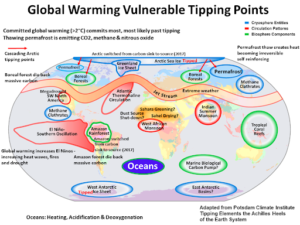In news– Recently, researchers have found that the Amazon rainforest is moving towards a “tipping point” where trees may die off en masse.
Key highlights of the study-
- A study suggests the world’s largest rainforest is losing its ability to bounce back from damage caused by droughts, fires and deforestation.
- Large swathes could become sparsely forested savannah, which is much less efficient than tropical forest at sucking carbon dioxide from the air.
- Previous studies have shown that parts of the Amazon are now emitting more carbon dioxide than can be absorbed.
- There are signs of a loss of resilience in more than 75% of the forest, with trees taking longer to recover from the effects of droughts largely driven by climate change as well as human impacts such as deforestation and fires.
What are Environmental Tipping Points?
- A tipping point in the climate system is a critical threshold that, when exceeded, leads to large and often irreversible changes in the state of the system.
- The term ‘tipping point’ is used by climate scientists to identify vulnerable features of the climate system.
- These “tipping points” are thresholds where a tiny change could push a system into a completely new state.
- The Intergovernmental Panel on Climate Change (IPCC) began considering the possibility of tipping points 20 years ago.
- Large-scale components of the Earth system that may pass a tipping point are called tipping elements.
- At least 15 different elements of the climate system, such as the Greenland and Antarctic ice sheets, have been identified as possible tipping points.
- A danger is that if the tipping point in one system is crossed, this could lead to a cascade of other tipping points.
- If a cascade occurs, this could cause a hothouse Earth in which global average temperatures would be higher than at any period in the past 1.2 million years.

Source: BBC














